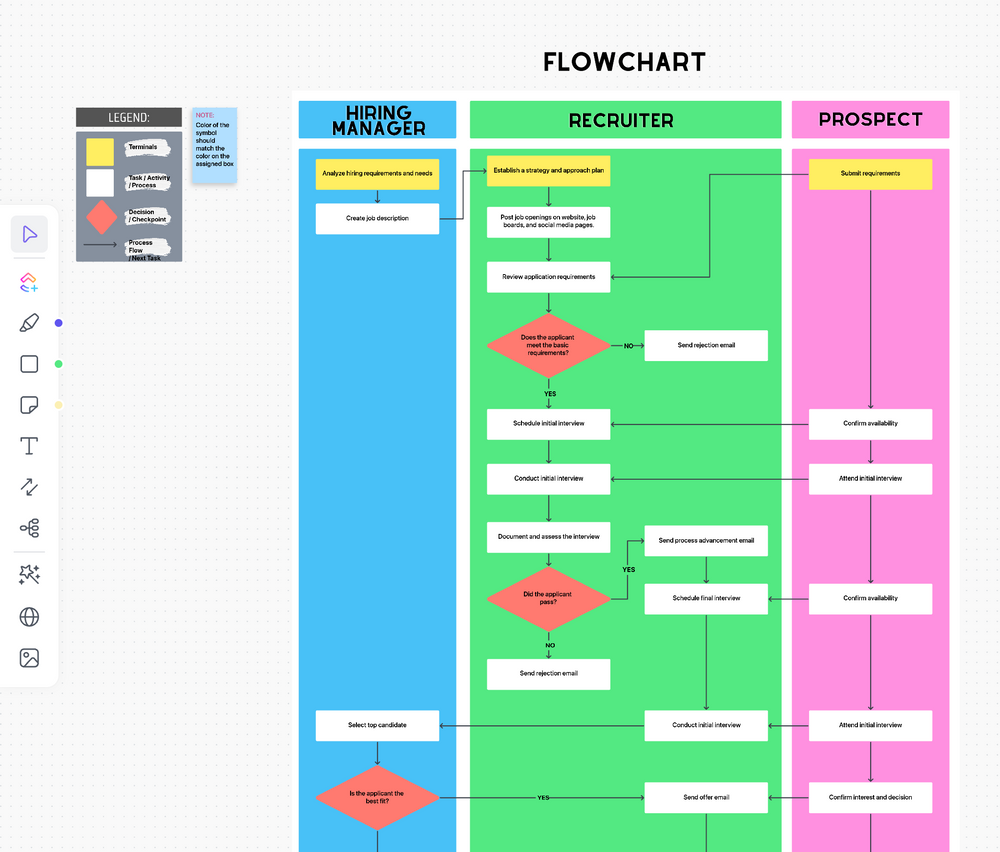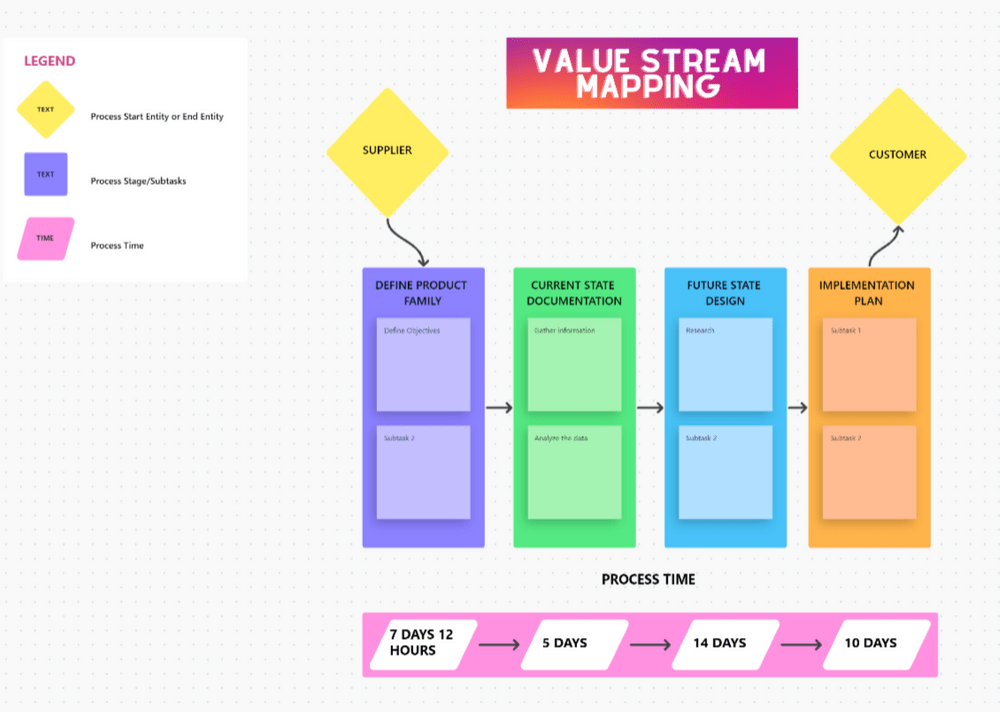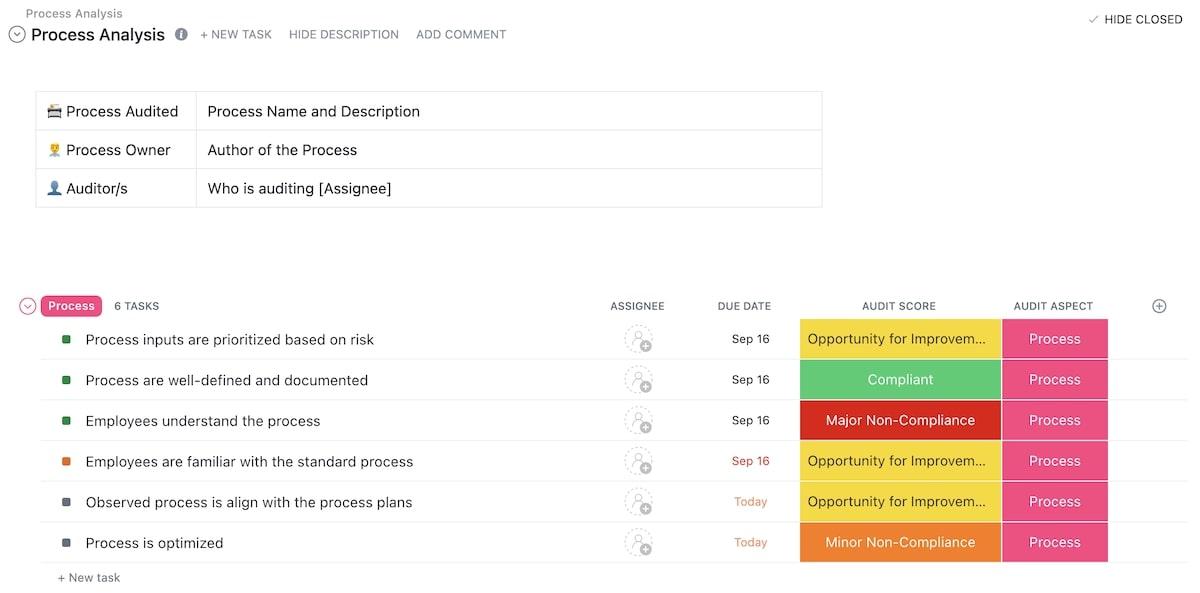

Processes will exist whether you deliberately design them or not. When you assign a task to someone, they create their own process, which they use repeatedly to make the job easier on them.
When asked to write this article, I opened a Google Doc, copied and pasted the outline, began research for each section, wrote, edited, proofread, added the hyperlinks, and sent it off for approval. If you had a dozen writers, you’d likely have a dozen processes.
However, to have consistency in how we write, edit, publish, and distribute as a brand, we can not afford to have a dozen processes. We need one uniform process.
You need a thorough process analysis to set up an efficient, effective, and uniform workflow. In this blog post, we’ll show you how you can set that up!
What is Process Analysis?
Process analysis is the systematic approach to understanding and documenting the inner workings of business activities. As per the business process management [BPM] school of thought, process analysis is an important part of continuous improvement.

The primary purpose of analyzing processes is to identify opportunities for improvement. To achieve this, a business process analysis typically studies:
- The steps being performed to complete a task
- How each step is performed
- How they impact the subsequent ones
- How they contribute to the project
- Who is responsible for each step
- Escalation matrices
- Redundancies and backup plans
- Challenges team members face in following the process
Once this is observed and documented, BPM teams look for ways to improve process efficiency without disrupting ongoing work.
Process analysis is not a one-time activity. In fact, it is best performed regularly, supporting continuous improvement. Here’s why.
Benefits of Performing Process Analysis
Good, ongoing, and strategic process analysis can help a business in numerous ways, including boosting the bottom line. Here’s how.
Understanding existing systems: Business process analysis is a fantastic way to take stock of things as they are. It helps measure efficiency and effectiveness by answering questions such as:
- Is our sales team using the CRM efficiently?
- Does everyone have clear visibility of the pipeline?
- Are all tickets being raised in the project management tool?
- Did the last sprint meet its goals?
- Is the customer service team being productive?
Identifying improvement opportunities: Once you’ve understood your existing process, you can also identify and bridge gaps. You can make decisions based on data rather than intuition. This is, of course, the most direct and straightforward benefit of process analysis.
Bringing operational efficiency: It is common for various teams to use their own processes. For instance, the sales team uses Salesforce to record interactions, customer success uses ClickUp to manage relationships, and marketing uses Hubspot to track progress. This allows for a lot of information to fall through the cracks.

Good workflow analysis enables better integration between these systems and facilitates seamless process flow.
Reducing operational costs: Business process analysis identifies redundancies, bottlenecks, and inefficiencies. Operations leaders can then eliminate these to reduce expenses in material procurement, energy consumption, and labor at the project development stage.
Increasing customer loyalty: Customers like a consistent experience. Business process analysis helps deliver that. More pertinently, it helps businesses identify issues and shortcomings of their customer experience and optimize workflows.
When you have an eye on your processes, you can observe recurring problems and proactively build solutions. You can also inform clients of upcoming issues in advance, building trust.
Compliance: No organization intends to be non-compliant. However, without continuous monitoring and attention, they sometimes overlook compliance issues.
Regular business process analysis prevents this and safeguards businesses from regulatory penalties and legal disputes.
Better employee experience: It is not just customers who will benefit from business process analysis. Efficient processes result in reduced workload and, hence, higher satisfaction. Motivated employees work harder, better, and towards higher profits.
Competitive advantage: In the highly competitive marketplace, real competition advantage is how you do things. Process analysis helps you monitor, evaluate, and refine your processes to maintain your competitive edge.
Now that you know why you need process analysis, let’s see the types and how to perform one.
Types of Process Mapping
As the name suggests, process mapping is a technique that helps visually map the process flow. It paints a picture of how a process is performed, what the steps involved are, who the stakeholders are, and how long it takes.
A process map offers a high-level view of everything involved, helping business operations teams simulate potential improvements.
You can make your process map in various ways. Some of the most commonly used methods are as follows.
Basic flowchart

The most popular and commonly used process map is the flowchart, made of boxes and arrows to represent a journey visually. Just because it’s basic doesn’t mean it’s limited.
A flowchart allows you to map complex processes with multiple dependencies and interconnections. It can accommodate steps, decisions, and multiple paths. It can also circle back to previous steps if any condition is unmet. You can choose from various flow chart templates in Word, PowerPoint, Excel, or ClickUp.
The Clickup process flowchart template visualizes a hiring process as an example. From a hiring manager’s request for a new resource to making an offer, this flow chart includes all the steps, stakeholders, and the flow from one step to the next.
Best for: Complex sequential processes involving multiple decisions.
Swimlane diagram

A swimlane diagram is an improvement on the basic flowchart. It uses the shape of a swimming pool to visually represent the business process, breaking down the project into lanes for each team/individual involved.
The swimlane flowchart helps bring everyone on board a project and collaborate effectively. It helps workflow optimization by delineating tasks and responsibilities clearly. These are commonly used in engineering teams for continuous integration/continuous development [CI/CD] while deploying incremental code changes.
Best for: Cross-functional teams working on a single process
Value stream map

Value stream maps help identify the inefficiencies in a process and clearly differentiate the value-adding and non-value-adding parts. Typically used in product teams, value stream maps facilitate four distinct steps:
- Define product family
- Document current state
- Design future state
- Create implementation plan
The primary goal of value stream maps is to design changes that lead to cost, time, and resource savings.
Use the ClickUp value stream mapping template to design the process, leave notes, attach files, and define objectives to outline your supply and delivery logistics. You can create and assign improvement tasks right within the template.
This doesn’t meet your needs? We have lots more. Check out the top ten value stream mapping templates to improve your team processes.
Best for: Teams that design processes from product to delivery
SIPOC

SIPOC stands for suppliers, inputs, processes, outputs, and customers. Under the Six Sigma methodology, SIPOC defines the boundaries and scope of an end-to-end process.
The method’s biggest advantage is its focus on the customer. To reflect that, some experts also use the term COPIS, putting the customer first.
Best for: Businesses that want to delineate steps and corresponding stakeholders
Business process model and notation [BPMN]

Designed by the Object Management Group, the business process model and notion is a detailed flowchart to map complex and interconnected business processes.
Like a flowchart, it includes stages for event, activity, flow, and gateway. Under each stage, there are multiple symbols.
For example, a gateway can be exclusive, inclusive, event-based, parallel, or a combination of these, each with its own symbol. Flow can be denoted as sequence flow, message flow, association, or data association.
With this level of detail, the BPMN gives enough detail to every stakeholder to enable precise implementation.
Best for: Businesses mapping processes end-to-end; most useful for software engineering teams
How to Perform a Process Analysis
Process analysis needs to be consistent, strategic, and cyclical. Let’s see how you can make that happen in your organization.
Define scope and purpose
While you must conduct a process analysis every six months, the scope and purpose won’t be the same each time. Depending on the maturity of the process you’re analyzing, this might vary dramatically.
So, begin by defining the following.
Scope: What processes will you analyze? What is the extent of the analysis?
For example, as a person responsible for customer success, you might analyze the customer’s entire post-purchase journey. Here, you will take a sample of customers, study the steps and milestones in their journey, listen to 1-2 calls, and interview a few customer success executives.
On the other hand, you might do an in-depth analysis of monthly customer reviews. In this case, you will listen to every customer review call over a specific period. You will make deeper observations about how the customer felt, their primary grievance, or what they want to see as the solution.
Purpose: What are you looking for? What action would you take on the findings?
The immediate purpose of any process analysis is to find opportunities for improvement, of course. However, some improvements might cost more; others might take longer or impact other parts of the organization. Think about what your goals are before you begin.
Bring a team together
Good process analysis needs the right experts. Pick a team of analysts who:
- Have experience with the processes you’re analyzing
- Use the process regularly
- Know why tasks are being performed the way they are today
- Understand its impact on the larger organizational workflows
Create a collaborative environment for them to discuss and debate their observations. The ClickUp task view and comments are a great way to enable this.

Understand the current state
Start with a qualitative analysis. While auditing existing processes, focus on both how and why. For example, you might learn that customer complaints are being recorded on a spreadsheet today. Ask why. There may be a business reason behind these choices.
Approach business process analysis with an open mind without judgment. Listen and collect information in as much detail as possible.

Once you clearly grasp the process, move to quantitative analysis. Collect key performance indicators around some of the following:
- Production/resolution times
- Rate of service level agreement [SLA] adherence
- Error rates
- Escalation rates
- Resource utilization
At this stage, you can also use several process mapping tools and methodologies to visualize your current state. Some examples and suggestions are in the next section.
Analyze carefully and thoughtfully
Once you have all the data, analyze it in context. Scrutinize each step in the process for inefficiencies, dependencies, and redundancies. This could be:
- Repetitive tasks performed by multiple people
- Team members not having enough to do
- Steps in the process taking too long owing to bottlenecks
- Too many errors, requiring additional resources to correct them
Before you suggest improvements, consider the following.
Benchmarking: How are other teams/departments/companies performing in similar processes?
Impact study: If an alternative step/method is suggested, what impact will it have on the team and the organization at large?
Resource analysis: What would it take for an alternative to be implemented? How much will it cost? How long will it take? Does it need additional training?
Disruption: During the change, what processes will be affected? How will this impact the business?
Suggest improvements
Based on your analysis, suggest improvements. This could be a simple change from using spreadsheets to onboarding ClickUp templates. It could also be a complete overhaul of the entire system. Whatever improvements you’re proposing, document them thoroughly.
List all changes: List all the changes you propose, however small or big they are. While documenting this, outline the current process and detail the proposed process. Highlight the changes.
Set priorities: It is never a good idea to change everything simultaneously. Prioritize the things you want to change and do them one at a time.
Set timelines: Begin with the steps that need immediate changes and expand incrementally. Create a project timeline broken down into tasks to be completed each week, month, quarter, or year. This also helps observe the process improvements and adjust any anomalies.
ClickUp’s Gantt chart view automatically creates a timeline based on the tasks and deadlines you’ve set on the project management tool.

Measure ROI: All change comes at a cost. So, document all the costs involved in implementing your improvements. Also, demonstrate the return on investment for each case.
Begin change management: No one likes a change unless it serves them. So, create a change management strategy, bringing every stakeholder on board. Explain your proposal to them and get their buy-in. Listen to feedback and adapt accordingly.
Incentivize change: Even your best efforts need the teams to play along. Is the sales team not updating the CRM regularly? Tie quarterly incentives to CRM updates. Some team members don’t like the new technology? Identify champions within the team and rally with them.
Keep an eye on the new business processes
Any process improvement initiative is only successful if it’s cyclical. So, the final step is circling back to the first one.
Once you’ve implemented the change, go back to step one and begin analyzing the new processes.
- Did the improvement have the desired impact?
- Have the metrics improved?
- Are there other gaps the new process has created?
From here, build your continuous improvement strategy.
Business Process Analysis in Action with a Clickup Template
If you’re new to process analysis or are looking to optimize how you’re performing them now, the ClickUp Process Audit and Improvement template is a great place to start.

Categorize: Use the template to categorize your process analysis tasks across process, resources, management, and monitoring. For instance, the task related to cleanliness is listed under resources and success metrics under management.
This helps you to assign process owners, manage activities, and track progress on every task.
Assign audit score: You can assign an audit score based on your observations for every task. For example, if the resources assigned to any part of the process is not adequate, you can give that a score.
The template gives options, such as compliance, opportunity for improvement, minor non-compliance, and major non-compliance. You can customize this based on how you want to score each task.
Upload evidence: No business process analysis is complete if you can’t substantiate your observations. This template allows you to upload evidence as photographs, screenshots, or documents.
Manage the project: Assign users, set due dates, add action items, and collaborate on comments. Use the audit scores board view to see the status of each task. Use the needs attention list view to monitor high-priority tasks.
Manage the process analysis as a project right within ClickUp.
Analyze and optimize your processes with ClickUp
Good project management is more than just task management. It enables every member of the company with the information, tools, and processes to do their best work.
An important part of good project management, irrespective of team size or industry, is regular process analysis and continuous improvement.
Yet, project teams today don’t have the time or resources to conduct regular business process analysis. Buried in the intensity of their everyday activities, process analysis takes a backseat.
Well, it shouldn’t. ClickUp’s various process analysis templates help you accelerate your journey and put ideas into action.
Try ClickUp for free today and see how it can improve your processes.




